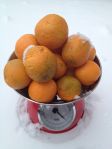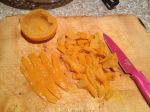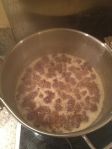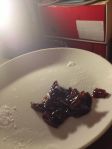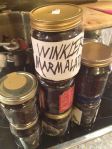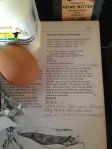
Winter’s Seville oranges season is over so this is for next winter’s marmalade (by which time the world will no longer be possessed by divide-and-rule politics and the UK has reversed extreme poverty described by the UN Special Rapporteur).
This ratio of oranges to sugar works well. Not too sweet. Excellent jelly-like consistency. A keeper.
3lbs Seville oranges
3lbs 12oz sugar
4pts water
1 pt water for pectin
2 lemons for pectin
My trusted slightly-edited marmalade recipe, which I owe to the late Katie Stewart, the Times cookery writer, is below. Beg or borrow a preserving pan.* Otherwise, use a pan deep enough for the marmalade to boil safely, and wide enough to allow a large surface to evaporate.
Top Katie Tips
- Place a saucer or two in freezer or fridge to encourage hot marmalade to cool quickly when testing it has set
- Put sugar (already weighed) in a pan in low oven to warm which will speed up boiling time
- Clean jars thoroughly with hot water and dry them in oven.
Five stages of making marmalade
Stage 1 Clean oranges and simmer to soften
- Scrub Seville oranges and remove stalks (organic oranges are worth it because better farming creates more taste and health)
- Use your largest pan or two smaller ones with lids
- Fill with 4 pints of water and simmer oranges for about an hour until peel is soft (orangey aroma will fill room)
- Drain cooked oranges and reserve cooking water – a precious liquid that becomes marmalade.
So far, this process can be done earlier, or the day before.
Stage 2 Extracting pith and pips for pectin
Pectin, extracted from the insides of the fruit, is the setting agent.
- Cut cooked-and-cooled oranges in half.
- Scoop-out their insides – the pitch-and-the pips – with a spoon
- Add pith-and-pips to a large-enough pan with the additional 1 pint of water and 2 lemons cut in half.
- Simmer for ten minutes then drain and reserve.
This pectin-rich liquid will be used in Stage 4.
Stage 3 Slicing peel
Flatten softened peel, and cut up peel of oranges (and the 2 lemons) with a small sharp knife as thinly/thickly as you like.
Stage 4 Rolling boiling
Take the warmed sugar from the oven. It should be in a preserving pan or largest pans (see above*)
Add the precious orange water (Stage 1), drained pectin-juice (Stage 2), and cut-up peel (Stage 3) in with sugar into preserving pan.
Start boiling.
It takes about 20-30 minutes to get the whole pan boiling and it is after that, you must watch like a hawk for the (ta-da) rolling boil.
Overboiling at this stage can stop the marmalade setting. So timing the rolling boil is important. After 15 minutes of a rolling boil, take the pan off the heat.
A rolling boil is when the marmalade is not just bubbling but is a fast-boiling glucky furious whirl.

Test for a set
Drop a spot of hot jam on one of those icy-cold plates
Let droplet cool, tilting plate to encourage cooling, then push droplet gently with your finger. You are looking for tell-tale wrinkles and jelly-like character. (The opposite to the lead in a romantic movie).
If the droplet is runny, boil again for a few minutes then test again. And so on until the test droplets are unequivocally set.
Stage 5 Marmalade in jars
Let jam cool in pan until not-too-hot yet not too-set for pouring.
Next, is the sticky bit so spread newspaper over kitchen surfaces, and use a ladle or a jug to pour the warm marmalade carefully into clean jars.
Recipes often say use waxed discs to keep out condensation and mould but, cutting-corners-cook that I am, I have not done so for years, with no adverse effects.
Wipe jars from stickiness and proudly label.


